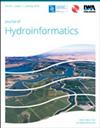Prediction of the discharge capacity of piano key weirs using artificial neural networks
IF 2.2
3区 工程技术
Q3 COMPUTER SCIENCE, INTERDISCIPLINARY APPLICATIONS
引用次数: 0
Abstract
The discharge capacity of the piano key weir (PKW) is an important flow feature which ultimately decides the type and geometric design of PKWs. In the present research work, the different architecture of artificial neural networks (ANNs) was employed to predict the discharge capacity of the trapezoidal piano key weir (TPKW) by varying geometric parameters (Si/So, Wi/Wo, Bi/Bo, L/W and α). Furthermore, adaptive neuro-fuzzy interference system (ANFIS), support vector machines (SVMs) and non-linear regression (RM) techniques were also applied to compare the performance of best ANN models. The performance of each model was evaluated using statistical indices including scatter index (SI); coefficient of determination (R2), and mean square error (MSE). The prediction capability of all the models was found to be satisfactory. However, results predicted by ANN-22(H-15) [R2 = 0.998, MSE = 0.0024, SI = 0.0177] was more accurate than ANFIS (R2 = 0.995, MSE = 0.00039, SI = 0.0256), SVM (R2 = 0.982, MSE = 0.000864, SI = 0.0395) and RM (R2 = 0.978, MSE = 0.001, SI = 0.0411). It was observed that Si/So, Wi/Wo and L/W geometric ratios have the greatest effect on the discharge performance of TPKW. Furthermore, sensitivity analysis confirmed that h/P is the most influencing ratio which may considerably affect the discharge efficiency of the TPKW. It was found that ANN models having a single hidden layer and keeping neurons three times of input parameters in hidden layers generated better results.利用人工神经网络预测钢琴键围堰的泄洪能力
琴键堰(PKW)的泄流能力是一个重要的水流特征,它最终决定了琴键堰的类型和几何设计。在本研究工作中,采用了不同结构的人工神经网络(ANN),通过改变几何参数(Si/So、Wi/Wo、Bi/Bo、L/W 和 α)来预测梯形琴键堰(TPKW)的排水能力。此外,还应用了自适应神经模糊干扰系统(ANFIS)、支持向量机(SVM)和非线性回归(RM)技术来比较最佳 ANN 模型的性能。每个模型的性能都通过统计指数进行了评估,包括散点指数(SI)、决定系数(R2)和均方误差(MSE)。所有模型的预测能力都令人满意。然而,ANN-22(H-15)[R2 = 0.998,MSE = 0.0024,SI = 0.0177]的预测结果比 ANFIS(R2 = 0.995,MSE = 0.00039,SI = 0.0256)、SVM(R2 = 0.982,MSE = 0.000864,SI = 0.0395)和 RM(R2 = 0.978,MSE = 0.001,SI = 0.0411)更准确。据观察,Si/So、Wi/Wo 和 L/W 几何比率对 TPKW 的放电性能影响最大。此外,灵敏度分析证实,h/P 是影响最大的比率,可能会严重影响 TPKW 的排放效率。研究发现,具有单个隐藏层并在隐藏层中保持三倍于输入参数的神经元的 ANN 模型能产生更好的结果。
本文章由计算机程序翻译,如有差异,请以英文原文为准。
求助全文
约1分钟内获得全文
求助全文
来源期刊

Journal of Hydroinformatics
工程技术-工程:土木
CiteScore
4.80
自引率
3.70%
发文量
59
审稿时长
3 months
期刊介绍:
Journal of Hydroinformatics is a peer-reviewed journal devoted to the application of information technology in the widest sense to problems of the aquatic environment. It promotes Hydroinformatics as a cross-disciplinary field of study, combining technological, human-sociological and more general environmental interests, including an ethical perspective.
 求助内容:
求助内容: 应助结果提醒方式:
应助结果提醒方式:


